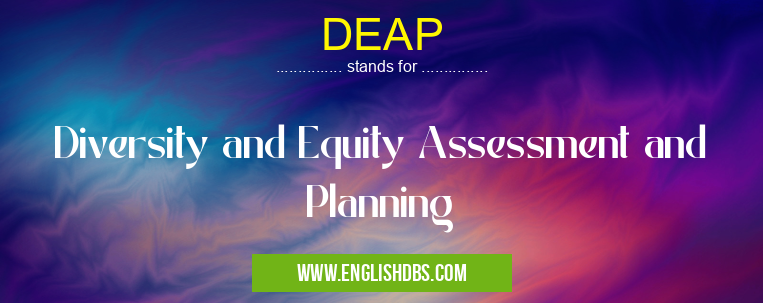What does DEAP mean in PLANNING
DEAP stands for Diversity and Equity Assessment and Planning. It is a tool used by organizations to assess their diversity and equity efforts and develop plans to improve them. DEAP can be used to assess an organization's progress in creating a more inclusive and equitable workplace.

DEAP meaning in Planning in Governmental
DEAP mostly used in an acronym Planning in Category Governmental that means Diversity and Equity Assessment and Planning
Shorthand: DEAP,
Full Form: Diversity and Equity Assessment and Planning
For more information of "Diversity and Equity Assessment and Planning", see the section below.
» Governmental » Planning
What does DEAP stand for?
DEAP stands for:
- Diversity
- Equity
- Assessment and
- Planning
What is DEAP?
DEAP is a process that helps organizations:
- Identify their diversity and equity strengths and weaknesses
- Develop plans to improve their diversity and equity efforts
- Track their progress over time
Benefits of DEAP
DEAP can have a number of benefits for organizations, including:
- Increased employee engagement
- Improved productivity
- Reduced turnover
- Enhanced reputation
How to conduct a DEAP?
There are a number of steps involved in conducting a DEAP, including:
- Collecting data on the organization's diversity and equity efforts
- Analyzing the data to identify strengths and weaknesses
- Developing an action plan to address the weaknesses
- Implementing the action plan
- Tracking the progress of the action plan
Essential Questions and Answers on Diversity and Equity Assessment and Planning in "GOVERNMENTAL»PLANNING"
What is DEAP?
Diversity and Equity Assessment and Planning (DEAP) is a comprehensive process designed to evaluate an organization's current state of diversity, equity, and inclusion (DEI) and develop a strategic plan for improvement.
Why is DEAP important?
DEAP is essential for organizations committed to creating inclusive and equitable workplaces. It provides a structured framework for assessing and addressing systemic barriers to DEI, fostering a culture where all employees feel respected, valued, and empowered to succeed.
What are the key elements of a DEAP process?
A comprehensive DEAP process typically includes:
- Data collection and analysis
- Stakeholder engagement
- Identification of strengths and weaknesses
- Development of a strategic plan
- Implementation and evaluation
Who should be involved in a DEAP process?
The success of a DEAP process relies on the active participation of stakeholders across the organization, including:
- Senior leadership
- HR professionals
- Employees from diverse backgrounds
- Diversity and inclusion advocates
- External consultants (if necessary)
What are some potential benefits of implementing DEAP?
Organizations that effectively implement DEAP initiatives may experience numerous benefits, such as:
- Increased employee satisfaction and engagement
- Improved recruitment and retention of diverse talent
- Enhanced innovation and productivity
- Strengthened reputation and brand image
How do I get started with a DEAP process?
To initiate a DEAP process, organizations should consider the following steps:
- Gain support and commitment from senior leadership
- Establish a DEAP team
- Develop a data collection plan
- Identify and engage stakeholders
- Create a timeline and budget
Final Words: DEAP is a valuable tool for organizations that are committed to creating a more inclusive and equitable workplace. By following the steps outlined above, organizations can use DEAP to assess their progress, develop plans to improve their efforts, and track their progress over time.
DEAP also stands for: |
|
| All stands for DEAP |
